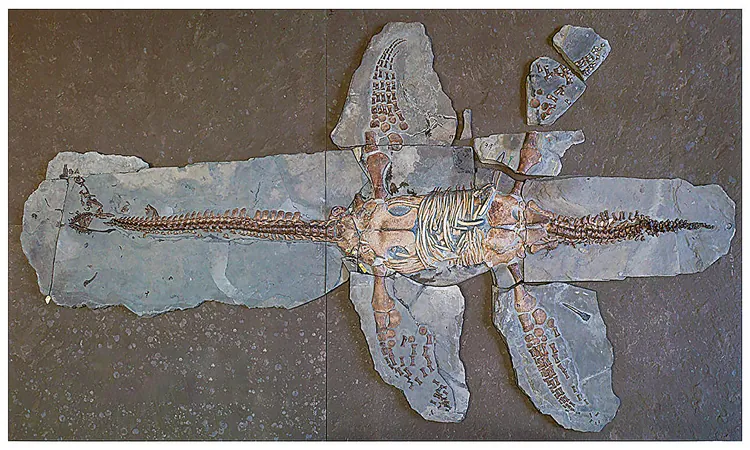
Ancient Fossil Reveals Stunning Secrets of Plesiosaurs' Skin and Evolution
2025-05-30
Author: Sarah
Unearthing the Past
In the depths of southern Germany, a remarkable discovery has changed our understanding of plesiosaurs, the long-necked marine reptiles known for their elegance. While most fossils reveal little more than bones, a sensational find from 183 million years ago has gifted scientists with invaluable insights into these ancient creatures.
The MH 7 Fossil
Discovered back in 1940 and long forgotten, the skeleton of Plesiopterys wildi was only recently freed from its limestone prison. Initial examinations in 2020 unveiled astonishing remnants of skin clinging to its tail and left flipper, transforming a routine study into a groundbreaking exploration of plesiosaur anatomy.
Skin Analysis Reveals Surprises
Using cutting-edge technology, researchers found that the skin on the tail was smooth and layered, rich with pigment granules called melanosomes. This discovery challenges the conventional image of uniformly pale marine reptiles, suggesting Plesiopterys may have had a more diverse color palette.
Moreover, the flipper showcased tiny, triangular scales, designed for precision swimming—much like modern sea turtles. This unique combination of textured scales and smooth skin might have provided Plesiopterys with both thrust and agility, an evolutionary marvel for swift maneuvering in water.
Plesiosaur Evolution and Adaptation
Lead author Miguel Marx from Lund University emphasized that the Holzmaden specimen offers unprecedented insights into plesiosaur evolution during the Early Jurassic. The research illustrates that specialized adaptations may have emerged earlier than previously believed, hinting at distinct plesiosaur communities in different European marine regions.
A Glimpse into Geological History
MH 7’s exceptional preservation is attributed to its origins in the Lower Jurassic Posidonia Shale, where low-oxygen conditions halted decay, allowing soft tissue to endure. This fossil is a rare treasure, giving scientists a glimpse of an ecosystem filled with ancient squids and diverse marine life.
Tail and Flipper Functionalities
Another fascinating aspect of this fossil is the discovery of a broad, fleshy tail fin, which suggests that Plesiopterys didn’t rely solely on its paddles for movement. This flexible, skin-lined feature could have aided in swift turns and rapid bursts of speed, comparable to today's penguin flukes.
Rewriting Plesiosaur Family Tree
Before this discovery, Plesiopterys wildi was somewhat of a mystery, known mainly through juvenile specimens. Now, researchers can accurately position it within the plesiosaur family tree, bridging primitive ancestors to later, more specialized forms. This evolution narrative unveils a world where every isolated marine pocket developed unique adaptations to their local environments.
Significance of Soft Tissue Discoveries
The MH 7 fossil’s revelations extend beyond academic curiosity. It provides evidence that can reshape our understanding of camouflage in prehistoric creatures and inspire modern engineering solutions by mimicking natural hydrodynamics. Each fragment of ancient skin serves as a crucial link to a vibrant world thriving beneath the waves while dinosaurs roamed above.
Preserving our Connection to the Past
As researchers delve deeper into fossils stored away for decades, they remind us of the importance of exploration and innovation in paleontology. Every piece of history, no matter how small, is a window to a distant time, rich with stories waiting to be uncovered.
Published in Current Biology, this groundbreaking study adds depth to our comprehension of marine reptile evolution and enriches our connection to Earth's prehistoric past.




 Brasil (PT)
Brasil (PT)
 Canada (EN)
Canada (EN)
 Chile (ES)
Chile (ES)
 Česko (CS)
Česko (CS)
 대한민국 (KO)
대한민국 (KO)
 España (ES)
España (ES)
 France (FR)
France (FR)
 Hong Kong (EN)
Hong Kong (EN)
 Italia (IT)
Italia (IT)
 日本 (JA)
日本 (JA)
 Magyarország (HU)
Magyarország (HU)
 Norge (NO)
Norge (NO)
 Polska (PL)
Polska (PL)
 Schweiz (DE)
Schweiz (DE)
 Singapore (EN)
Singapore (EN)
 Sverige (SV)
Sverige (SV)
 Suomi (FI)
Suomi (FI)
 Türkiye (TR)
Türkiye (TR)
 الإمارات العربية المتحدة (AR)
الإمارات العربية المتحدة (AR)